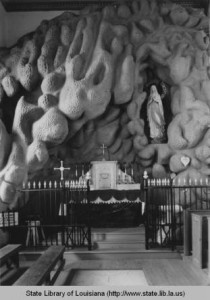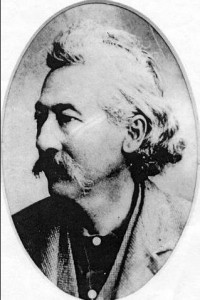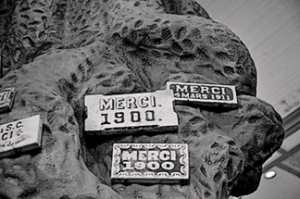In February 1858, a young girl by the name of Bernadette Soubirous was out gathering firewood with her sister and a friend at a grotto just outside of Lourdes in southwestern France. There appeared to Bernadette a beautiful lady standing in a niche in the rock. The lady wore a white veil and a blue girdle with a golden rose on each foot and a beautiful rosary in her hands. From February to July of that year, the Lady appeared to Bernadette at the grotto eighteen times. These visions, which Bernadette reported, caused much excitement among the people of the region, her parents, her priest, and local authorities. Some doubted although many believed, even the priests of the locale were skeptical, and asked that she inquire of the beautiful lady just who she was. On March 25th, the Lady answered Bernadette by saying “I am the Immaculate Conception.”
Soon after these apparitions, work was begun on a chapel to be erected at the site and in 1864, a statue was created by a local artist based upon Bernadette’s description of the Lady, then known to be our Blessed Mother. Pilgrims began flocking to Lourdes in droves – many came to bathe or to take home water where the miraculous spring at the site. In 1876, the first of several basilicas was erected in the vicinity, where Mass could be celebrated for the growing numbers of pilgrims.
Far away from Lourdes, in France’s old province of la Louisiane, now an American state, a postcard of the grotto at Lourdes brought inspiration to a colored Creole man named Pierre François Hyppolite Martinet (1847-1905). Hyppolite, or “Polite” as he was sometimes called, was a native and resident of Saint Martinville, that beautiful village along the Bayou Teche, where a sculpted Évangéline, much sought by tourists, has long waited for her lover Gabriel. The son of Hyppolite Pierre François Martinet, a native of Belgium, and Marie-Louise Benoit, a free woman of color, Hyppolite was a builder and architect who was married to Fidélice Sidonie Detiége. He also was the brother of Louis-André Martinet, a lawyer and physician in New Orleans, who was a leader of the Comité des Citoyens, which funded the Plessy v. Ferguson case.
Inspired by the postcard he saw and filled with devotion to Notre-Dame, he set out in the late 1870s or early 1880s to reconstruct the grotto in his parish church of Saint Martin de Tours. He used materials common to his trade, mud and plaster, to create a beautiful and lasting tribute. Inside the niche was placed a statue like the one at Lourdes, with the following words encircling the head of the Blessed Lady: “Je suis l’Immaculée Conception” (“I am the Immaculate Conception”).
The grotto at l’Église Saint-Martin stands today just as it did over one hundred and thirty years ago. The area surrounding the grotto is filled with ex votos or votive offerings left by the faithful over the years, some of these are dated well over a century ago and many simply bear the word merci in the mother tongue of the dear people of the Teche country. It is a testament to the craftsmanship of its builder and to the faith of him and countless other Catholics of color who have lent their prayers, talents, and treasures to the Church.
Source: Leona Martin Guirard, St. Martinville: The Land of Evangeline in Picture Story, Privately Published, 1950. Thanks are due to Christophe Landry for the photograph of Hyppolite Martinet. Merci, mon confrere!
Jari C. Honora






Fidelice Sidonie Detiege was the daughter of my great-grandfather (x3) Edouard Detiege. Edouard as born in 1816 in Hamme-Mille, Belgium. He was naturalized on Feb. 24, 1853 in St. Martinville. He married Pamela Charlotte Isidore, a free woman of color, Dec. 4,1869. My grandfather,Jerome Detiege, my great grandfather,George Detiege,and my great grandfather(x2)Jean Philippe Detiege were born in St Martinville.
My great grandfather (x4) also named Jean Phillippe Detiege was born in Belgium in 1777.
Wendell… Thanks for sharing your ancestral connection to this article. We just wish that more Creoles of color would research their families the way you have since so many of us have such a rich and fascinating past!
Pierre F. Hyppolyte Martinet & Fedelice Sidone Detiege were the parents of my great-grandfather Honorat Martinet.
Any other information would be greatly appreciated.
Brandy
My research has been on the Detiege side,(my mother is a Detiege).The only info I have on Fedelice and Pierre is that they married April 18, 1871. Fedelice was born May 1856. Feel free to contact me.
Hi Brandy,
Just get ahold of me. I have a great deal of information.
Tom (Art) Martinet
702-533-8908
thomasmartinet@Hotmail.com
Hi,
I would love to talk to you. I also have a great deal of “family” history.
Tom (Art) Martinet
702-533-8908
thomasmartinet@Hotmail.com
Hi Wendell,
My name is Thomas Arthur Martinet. (your cousin)
Along with Brian Martinet, Tom Edward Martinet, and Ann McGuffey, I have done a lot of “family” genealogy. I would sure love to add all that you have. I do have you grandfather listed in my info, but it basically ends there. If you have additional infp, I would love to get it.
Thanks,
Tom (Art) Martinet
thomasmartinet@hotmail.com
702-533-8908
There was a grotto in New Orleans to which Pilgrims came and said prayers as they moved to the Mary statue on their knees. Does anyone know about this? Does it still exist?
Thank you for visiting CreoleGen! We appreciate the continued support of our readers like yourself! – The shrine you are thinking of is the Saint Ann Shrine located on Ursuline Avenue. The shrine has a replica of the Scala Sancta “Holy Stairs,” which are located in Rome. These stairs according to custom were the ones Jesus ascended in Pilate’s palace. The Saint Ann Shrine has a replica of the Lourdes Grotto and several other statues.
Thanks for sending this. I missed the original reply and this comes just in time for Christmas. A wonderful gift.
I am the grandson of Edouard Martinet and Edvige LaDoux (Rochon) Martinet. In our family tree is the name Detiege. Reading the book “One Drop” by Bliss Broyard which chronicles Creoles and Cajuns, there is a section about Emille Detiege(s) who was supposedly the first Black officer in the Union army in LA. Do you know anything about the lineage concerning Emille Detiege? Also, no one in our family has been able to find a picture of Louis A. Martinet of the Plessy vs Ferguson fame.
Hi! I do historical research about my village “Hamme-Mille” in Belgium. More partcularly about somme people who have still a tombstone posed against the extern walls of our church “St Amand”. Among the stones are they of:
– Jean François Detiège born in Hamme-Mille on 23 january 1803
-Alexandre Napoléon Martinet born in Uccle on 16 juny 1811
-all both parents with Jean François Brasseur born in Hamme-Mille in 1796 and missionaris in Louisiana between 1830 and 1840. He was the priest in St-Martinsville from 1836 to 1840.
I am searching for more information…
There are two family historians, Brian Martinet and Ann McGuffey, who are eagerly researching the Martinet and Detiege families.